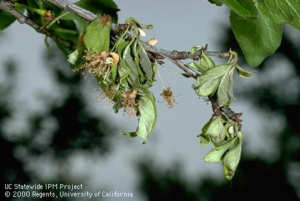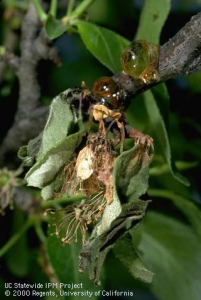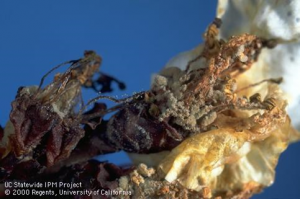Updated March 2019; originally published May 2016.
Joe Connell, UCCE Farm Advisor Emeritus, Butte County; Richard Buchner, UCCE Farm Advisor Emeritus, Tehama County; Franz Niederholzer, UCCE Farm Advisor, Colusa/Sutter/Yuba Counties and Jim Adaskaveg, Professor, UC Riverside
Brown rot blossom/twig blight caused by Monilinia species is the most important blossom and pre-harvest (fruit) disease of prune in California. Generally, M. laxa is the primary pathogen on blossoms, whereas M. fructiola is the main pathogen on fruit. However, both species can cause blossom blight and fruit rot under favorable environmental conditions. Properly timed fungicide treatments can most effectively protect your trees and prevent this disease.

The source of spring brown rot infections are the old infections from last year. The brown rot fungus produces spores from infected fruit mummies on the orchard floor and left in the tree, twig cankers on the branches, and on any remnants of infected flower parts. These spores are transported by wind or rain splashes. Good orchard sanitation – removing mummified fruit, pruning out blighted shoots, and cultivating the orchard floor to bury mummies – reduces the amount of spores and the risk of infection. Spraying is still necessary after sanitation, but the risk of major and wide-spread damage is reduced.

All prune flower parts are susceptible to brown rot blossom infections from green bud through petal fall. Brown rot fungi grow and reproduce rapidly at temperatures from 60-80°F. Infections do not develop below 50°F. Initially infected flowers turn brown, wither and remain attached to fruit spurs. Twig cankers form on the wood at the base of infected blossom spurs. As blossom infections extend into the twigs, shoot death is caused by girdling. Gumming occurs at infection sites, and grey-brown spore masses may be visible under high humidity.

Proper timing of bloom sprays is crucial for control. The challenge is anticipating severe disease conditions. Location of the orchard (soil-type, water drainage, micro-climate effects of rivers, foot hills, etc.), type of irrigation system (high or low canopy wetness), history of disease at the orchard site (especially in the previous growing season), amount of expected precipitation (dews and rainfall) and expected temperatures all contribute to estimating the “disease pressure”.
A two-spray program (green/white bud and full bloom) aimed at both brown rot (green bud, full bloom) and russet scab (full bloom) is a good choice in wet years, especially when temperatures top 60oF. When no rain falls at bloom, a single bloom spray applied at 20-30% bloom provides effective control. With this strategy, a fungicide or mixture with post-infection activity is preferred. Fungicide treatments are most effective when allowed to dry thoroughly before rainfall.
Good spray coverage is essential for effective disease control. Calibrate your sprayer and check coverage before spraying. Spray every row to ensure complete coverage and the best possible disease control while reducing the risk of fungicide resistance development. For the most up-to-date efficacy information, see the publication: Fungicides, Bactericides, and Biologicals for Deciduous Tree Fruit, Nut, Strawberry, and Vine Crops.
Managing Disease Resistance
There is no guarantee that an effective fungicide will work forever, especially “single-site” fungicides that only target one chemical pathway. If a mutation develops a way around the blocked pathway, the fungicide may not work on that population. In a few Sacramento Valley orchards, brown rot is resistant to cyprodinil (Vangard®). You can help preserve fungicide choices and provide effective disease control by practicing good disease resistance management. Here are some steps to consider:
- Alternate fungicide classes. For example, if you sprayed Vangard (FRAC 9) at green bud, then don’t use Scala (FRAC 9) at full bloom. Use Indar or Orbit (FRAC 3) or Rovral (FRAC 2) or another effective material not containing FRAC 9 material. [Note: the EU is lowering acceptable MRLs on some fungicides and Rovral has specifically been called out. Be sure to talk to your handler about where your crop will be marketed and what materials they prefer you avoid].
- Use full label rates. Sub-lethal treatments increase the chance for resistant brown rot to survive.
- Don’t over use a fungicide. Limit the number of times you use the same fungicide active ingredient to once or maybe twice per year. Change chemistry, not just pesticide trade names. For example, propiconazole is registered as Bumper, Tilt, Orbit, and other names, so any combination of those fungicides should be used only once or maybe twice per year to limit the risk of brown rot resistance to the chemical developing.
- Deliver excellent spray coverage. Solid sprays providing good, uniform canopy coverage are essential for good disease control. When poor spray coverage (e.g. every-other-row spraying) results in a sub-lethal dose, resistant strains of the disease are favored.
- Watch for trouble. Identify orchards with suspected resistance. If you suspect brown rot resistance, contact your local farm advisor so samples can be collected and analyzed.


Leave a Reply